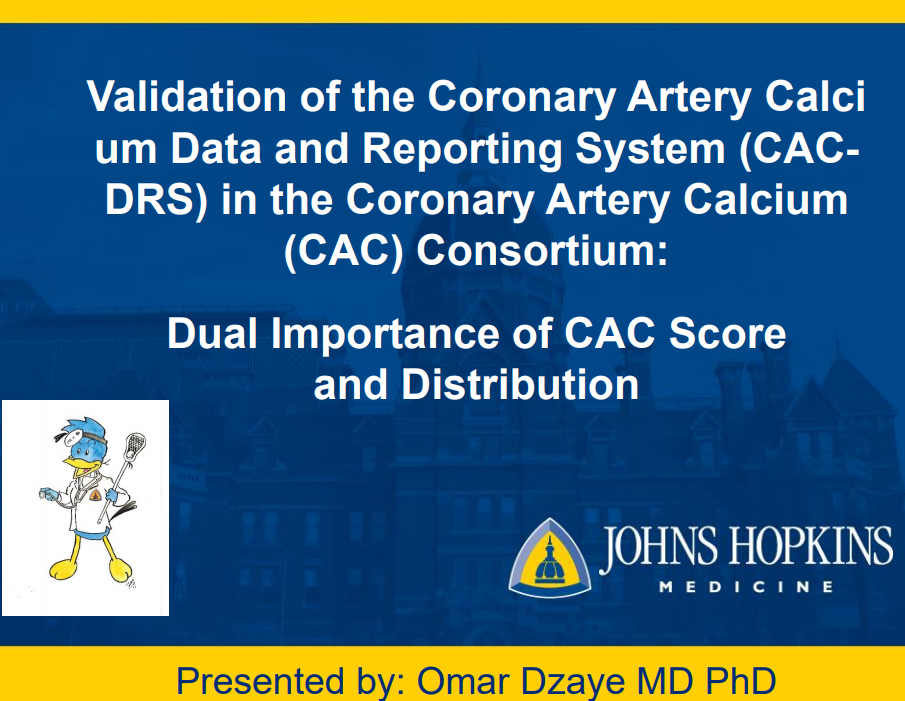Retrospective Study Validates CAC-DRS Score for Predicting Mortality
Some see the potential to simplify and boost the use of CAC assessment while being better able to predict CVD death.

BALTIMORE, MD—A novel system for scoring coronary artery calcium that combines the long-used Agatston score with the number of calcified vessels provides better long-term risk stratification for cardiovascular disease-related death than the Agatston score alone, according to a new retrospective study.
Moreover, the Coronary Artery Calcium Data and Reporting System (CAC-DRS)—which was introduced last year as a simple yet consistent method of quantifying risk by measuring calcium—can be applied even to nongated CT scans, meaning that patients who undergo imaging for a noncardiac reason will be able to also learn if they are at risk for cardiovascular disease.

“We think this CAC-DRS score has the potential to systemize scoring from gated and nongated studies,” said Omar Dzaye, MD, PhD (Johns Hopkins Ciccarone Center for Prevention of Heart Disease, Baltimore, MD), who presented the findings earlier this month at the annual Society of Cardiovascular Computed Tomography (SCCT) meeting. “It really supports also the new SCCT guidelines to educate radiologists and cardiologists about this simple scoring system, and what would be possible is a reinterpretation of existing gated and nongated images for a rapid assessment with additional predictive value,” he told TCTMD.
Harvey Hecht, MD (Mount Sinai Medical Center, NY), who was not involved in the study but led the creation of CAC-DRS, commented to TCTMD that he was “pleasantly surprised” by how well the score correlated with risk in this study. “We don't want it to be looked at after the fact. We want the calcium part of it to be reported at the same time as the noncalcium part is reported . . . because it's free,” he said. “The information is there and the prognostic value of calcium on the [nongated] CT is basically as strong as it is for the gated calcium scores, which was a bit surprising but very gratifying as well.”
Better Prediction With CAC-DRS
For the study, Dzaye and colleagues included 54,678 patients from the CAC Consortium who had a mean ASCVD risk score of 7.3%, mean CAC score of 1, and median of two vessels with CAC. Over a mean follow-up of 12 years, 2,469 patients died.
They observed a direct correlation between the CAC-DRS score—which has a 0-3 classification based on Agatson score and a 0-4 indication for the number of vessels involved—and CHD and CVD death risk. Specifically, those with an A0 score (no CAC) had an all-cause mortality rate of 1.2 per 1,000 person-years and those with an A3/N4 score (Agatston score > 300 with four vessels involved) had an all-cause mortality rate of 15.4 per 1,000 person-years. On multivariate analysis, A3/N4 patients were at significantly higher risk of CHD mortality (HR 5.9; 95% CI 3.6-9.9), CVD mortality (HR 4.0; 95% CI 2.8-5.7), and all-cause mortality (HR 2.5; 95% CI 2.1-3.0) compared with A0 patients.
Using CAC-DRS scoring system, the researchers were more accurately able to predict death related to CVD and CHD as well as all-cause mortality compared with the traditional CAC score groups or the number of vessels involved alone (P < 0.001 for all).
Area Under the Curve for Risk Prediction
|
|
CHD Death |
CVD Death |
All-Cause Death |
|
CAC-DRS |
0.795 |
0.762 |
0.700 |
|
Number of Vessels |
0.780 |
0.748 |
0.687 |
|
CAC Score Groups |
0.785 |
0.754 |
0.696 |
Dzaye noted that their study lacked any visual analysis of the lesions, the third component of the CAC-DRS score, as well as the potential for referral bias and lack of generalizability, since white individuals comprised 90% of the cohort. However, “the CAC consortium represents the largest database of CAC scans related to long-term cause-specific mortality,” he said.
For his presentation, Dzaye was awarded first place in the Siemens Outstanding Academic Research (SOAR) Awards at the meeting.
‘One Step Forward’
“When we were tasked with devising the scoring system, there were two goals really: one to make it accurate and reflect the risk, and two to keep it relatively simple. Were it not simple, adoption would be minimal,” Hecht explained, adding that they could have included data points such as the plaque’s location in the vessel and in which specific artery. “But the feeling was that would have made it much too complicated and discouraged adoption. And the other major point was that it should be applicable not just to dedicated calcium scores that were acquired in a gated fashion but to any noncontrast chest CT, because the amount of calcified plaque is readily viewable and easily scored by a visual rather than an Agatston analysis.”
This study “absolutely” supports these goals because “it shows that the outcomes are proportional to the scoring system. The worse the score, the worse the outcomes,” Hecht observed.
The current plan is to update the CAC-DRS score every 3 years, and it’s likely that the next iteration will include information regarding the density of the calcified plaque, he said. “My only concern about that is the more complicated it gets, the less likely it is to be adopted. . . . So it's a trade-off. The major purpose of it is to make the scores reported in a relatively uniform way with the minimum effort. So the more complicated you make it, the more you defeat that purpose.”
In the future, Dzaye said he could see the CAC-DRS calculated automatically, requiring only limited involvement of the interpreting clinicians.
Ultimately, this score and study make “one step forward in the more universal adoption of coronary calcium, which has been woefully unadopted in the general practice of medicine,” Hecht concluded. “So anything that can be done to make it more accurate is a major step forward.”
Yael L. Maxwell is Senior Medical Journalist for TCTMD and Section Editor of TCTMD's Fellows Forum. She served as the inaugural…
Read Full BioSources
Dzaye O. Validation of the Coronary Artery Calcium Data and Reporting System (CAC-DRS) in the Coronary Artery Calcium (CAC) consortium: dual importance of CAC score and distribution. Presented at: SCCT 2019. Baltimore, MD. July 12, 2019.
Disclosures
- Dzaye and Hecht report no relevant conflicts of interest.


Comments